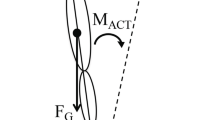Abstract.
This paper tests the hypothesis that the central nervous system (CNS) learns to organize multijoint movements during a multijoint ‘bouncing pull’ task such that, after practice, motion of the anterior-posterior center of mass (CMAP) more closely resembles that of a conservative, one degree of freedom (DF), inverted pendulum model. The task requires standing human subjects to produce precise peak pulling forces on a handle while maintaining balance – goals that can be easily accomplished if movement is organized as in the model. Ten freely standing subjects practiced making brief, bouncing pulls in the horizontal direction to target forces (20–80% of maximum) for 5 days. Pulling force, body kinematic and force plate data were recorded. An eight-segment analysis determined sagittal-plane CM motion. We compared the effects of practice on the regression-based fit between actual and model-simulated CMAP trajectories, and on measures of CMAP phase plane symmetry and parameter constancy that the model predicts. If the CNS learns to organize movements like the inverted pendulum model, then model fit should improve and all other measures should approach zero after practice. The fit between modeled and actual CMAP motion did not improve significantly with practice, except for moderate force pulls. Nor did practice increase phase plane symmetry or parameter constancy. Specifically, practice did not decrease the differences between the pre-impact and rebound positions or speeds of the CMAP, although speed difference increased with pulling force. CMAP at the end of the movement was anterior to its initial position; the anterior shift increased after practice. Differences between the pre-pull and balance-recovery ankle torque (T A) impulses were greater on day 5 and correlated with the anterior shift in CMAP. These results suggest that practice separately influenced the force production and balance recovery phases. A modified model with damping could not explain the observed behaviors. A modified model using the actual time-varying TA profiles improved fit at lower force levels, but did not explain the increased postural shift after practice. We conclude that the CNS does not learn to organize movements like the conservative, inverted pendulum model, but rather learned a more complex form of organization that capitalized on more time-varying controls and more intersegmental dynamics. We hypothesize that at least one additional DF and at least one time-varying parameter will be needed to explain fully how the CNS learns to organize multijoint, bouncing pulls made while standing.
Similar content being viewed by others
Author information
Authors and Affiliations
Additional information
Received: 9 January 1997 / Accepted in revised form: 27 May 1997
Rights and permissions
About this article
Cite this article
Lee, W., Patton, J. Learned changes in the complexity of movement organization during multijoint, standing pulls. Biol Cybern 77, 197–206 (1997). https://doi.org/10.1007/s004220050380
Issue Date:
DOI: https://doi.org/10.1007/s004220050380




